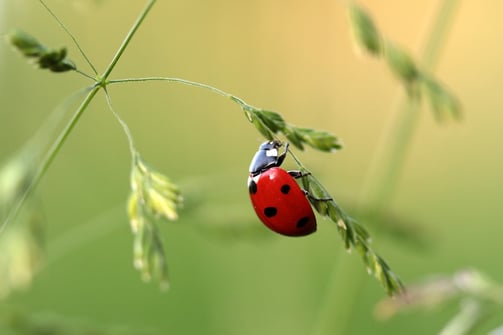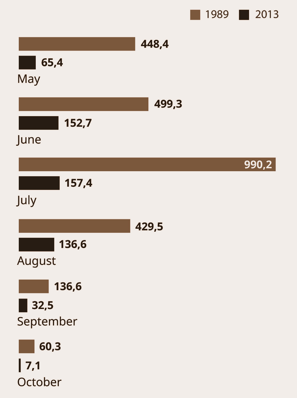Insect Extinction
Presentation | Secondary Research
COLLEGE FOR CREATIVE STUDIES
Introduction
The topic of insect extinction may not always be in the spotlight, but it's critical. While we have affection for some insects, such as ladybugs and butterflies, others tend to be associated with nuisance – the bugs in our apps or annoying pests. This bias sometimes leads to the de-prioritization of insects in sustainable development efforts.




Insect Population Decline Trends
This image shows a study conducted in the Orbroicher Bruch Nature Reserve, Germany. Similar studies worldwide reveal alarming trends in insect population decline.
Source imagery: Entomologischer Verein Krefeld
Habitat Loss & Fragmentation
Habitat Loss: One of the primary factors driving insect population decline is habitat loss across studies.
Human Activities: This includes the use of genetically modified (GMO) crops, monoculture farming, and the construction of highways and dams, all of which lead to habitat fragmentation.
Eg. Milkweed is a native wild plant that is considered a weed but it is one of the main host species for monarch butterflies. The loss of milkweed has contributed to the sharp decline of the monarch butterfly population.
01.
Why are Insects Dying So Fast?
02.
Pesticides
Chemical Impact: Pesticides, including chemical fertilizers, have significant detrimental effects. They create toxicity in both target and non-target insects.
Environmental Impact: Pesticides don't just disappear; they get absorbed into soil and water, rendering these environments inhospitable to insects for years.
Disrupting Ecosystems: Contaminated smaller insects become prey to larger insects and animals, disrupting the food chain.
03.
Pollution
Water Pollution: Many insects, including mosquitoes and dragonflies, begin their lives as water-dwelling larvae. Water pollution has a significant impact on their survival and development.
Noise Pollution: Noise pollution affects insect behavior.
Light Pollution: Insects with aquatic larvae, such as mayflies and dragonflies, can become disoriented by artificial light. They may mistakenly lay their eggs on wet roads or car roofs, which reflect horizontally polarized light like bodies of water.
Eg. Female crickets may struggle to find the best mates when noise pollution masks the songs of males.
04.
Climate Change
Climate Impact: Rising temperatures have led to increased frequency and intensity of droughts, wildfires, and the drying of swamps and wetlands. These events have severe consequences for insect populations.
Cold-Blooded Sensitivity: Insects are cold-blooded, or ectothermic, which means their body temperature depends on the environment. They are highly sensitive to temperature changes, and the warming climate disrupts their life cycles.
Mismatched Timings: Changes in the timing of plant blooming, driven by altered temperature and weather patterns, can disrupt the delicate balance between insects and their host plants. Insects have evolved to seek out these plants at specific times, and a mismatch can be detrimental.
of around 100,000 identified pollinators are insects
98%
Why They Need to Be Protected?
90%
of 200,000 flowering plant species depend on pollinators
15%
of the largest crop species are pollinated by domesticated bees alone
Ecosystem Functions
Insects play critical roles in ecosystems— pollination, biological pest control, and the decomposition of organic matter.
What's in it For Us?
Biodiversity Sustainers
Many species, like bats, birds, and freshwater fish, depend on insects as a primary food source. Additionally, dung beetles help return essential nutrients like nitrogen and carbon back to the soil.
Muses for Innovation
Biomimicry draws inspiration from insects, such as beehives, spider webs, and termite hills, to design innovative products and processes. Biomaterials inspired by insect proteins, like chitin, are also advancing.








Traditional Medicine
In various cultures, insects are used in traditional medicine. For example, fly maggots are employed to clean dead tissue in wounds, silkworms and dried ants are part of a few traditional Chinese medical practices. In traditional Mexican medicine, the Copalchi beetle has been used as a remedy for diabetes and to treat digestive issues.


Natural Dyes
Insects, like the cochineal (scale insect), have been historically used as sources of natural dyes. The Aztecs, for instance, used cochineal to produce red dye, and it is still used today in cosmetics and as a natural food coloring.


Precious Products
Insects are responsible for producing valuable products. Bees, for example, deliver approximately 1.2 million tonnes of commercial honey each year, and silkworms produce over 90,000 tonnes of silk.
Green Urban Planning
In our cities and towns, green urban planning can make a significant difference. Regulations for local parks and gardens should include wild areas that offer habitats for insects and other wildlife.
01.
What Can We Do?
Designing for Insects
02.
Sustainable Agriculture
Sustainable farming practices like biocontrol, regenerative and polycultural agriculture can reduce the need for chemical pesticides. Barriers in large farms can also help protect ecosystems. Leaving uncultivated strips in large farms like hedgerows to house spiders and beetles that in turn safeguard the crop from pests is a win-win.
03.
Wildlife Corridors
Preserving natural grasslands with woody plants allows insects and other species to move freely and maintain genetic diversity.
04.
Lighting Solutions
We can replace white LEDs with red ones, limit their use based on necessity, dim or turn off lights when not in use, and shield them to prevent light pollution.
Biocontrol is an ecologically friendly pest management strategy that involves the use of natural enemies, including predators, parasites, and pathogens, to regulate and reduce the populations of harmful pests in agriculture. Insects like ladybugs, lacewings, predatory mites, beetles, and preying mantises are among the unsung heroes in biological pest control. They play a crucial role in maintaining a balance in agricultural ecosystems.
Insects as Sustainable Solutions
Entomophagy is the practice of consuming insects as food. It has been a traditional and sustainable source of nutrition in many cultures for centuries. In recent years, entomophagy has gained attention as a potentially eco-friendly and sustainable solution to food security. Traditional insect harvesting practices often involve collecting non-threatened insects from the wild, which can help protect these insects and their ecosystems. Larval flies, for example, can be used to transform livestock manure into valuable resources like fertilizer and consumable protein for animal feed, contributing to a circular and sustainable agricultural system.
Perry, K.I. (2022) ‘Conserving Forest Habitat for Wildlife: Providing Context to a Landscape Design that Engages the Public in Nonnative Insect Management’, Ecological Restoration, 40(2), pp. 1–4. doi:10.3368/er.40.2.128.
Lewis, S.M. et al. (2020) ‘A Global Perspective on Firefly Extinction Threats’, BioScience, 70(2), pp. 157–167. doi:10.1093/biosci/biz157.
Yong, E. (2022) ‘Our Blinding, Blaring World. (cover story)’, Atlantic Monthly (1993), 330(1), pp. 62–74. Available at: https://search-ebscohost-com.meredith.collegeforcreativestudies.edu/login.aspx?direct=true&db=mat&AN=157481390&site=ehost-live (Accessed: 19 October 2023).
Forister, M.L., Pelton, E.M. and Black, S.H. (2019). Declines in insect abundance and diversity: We know enough to act now. Conservation Science and Practice, [online] 1(8). doi:https://doi.org/10.1111/csp2.80.
Wirth, G. (2022) ‘Fostering Insect-Human Relationships through Design’, Ecological Restoration, 40(2), pp. 1–5. doi:10.3368/er.40.2.103.
The contribution of insects to food security, livelihoods and the environment 1 Why insects? (n.d.). Available at: https://www.fao.org/docrep/018/i3264e/i3264e00.pdf.
Laichattiwar Mukesh Anandrao (2020) Conservation and Restoration of Insect Population. Ashland: Delve Publishing. Available at: https://search-ebscohost-com.meredith.collegeforcreativestudies.edu/login.aspx?direct=true&db=e000xna&AN=2725285&site=ehost-live (Accessed: 19 October 2023).
